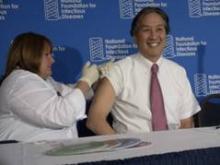WASHINGTON – Vaccination against the flu is on an upswing in the United States, with more than half of eligible children receiving the vaccine last year, but it’s important to keep the momentum going and encourage early vaccination this season, according to a panel of health care professionals.
"Don’t hesitate, vaccinate," said Dr. Howard K. Koh, assistant secretary for health at the U.S. Department for Health and Human Services. Dr. Koh was one of several health officials, who spoke today at a press conference sponsored by the National Foundation for Infectious Diseases (NFID).
This year, an ample supply and multiple choices of vaccines should make it easy for health care providers to get vaccinated themselves and promote vaccination for their patients, said Dr. Koh. The Affordable Care Act provides coverage of all recommended vaccines, including flu vaccine, he noted. The flu is "predictably unpredictable" and hit hard and early last year, so there is no reason to delay vaccination, he said.
Flu vaccination for children aged 6 months to 17 years reached an all-time high of 57% last year, a 5% increase from the previous year, said Dr. Anne Schuchat, assistant surgeon general and director of the Centers for Disease Control and Prevention’s National Center for Immunization and Respiratory Diseases. Flu vaccination is now recommended for everyone, and even the historically vaccination-resistant 18-49-year-old age group showed an increase to 31% last year, up 2.5% from the 2010-2011 season, which is encouraging, Dr. Schuchat said.
Approximately 135 million influenza vaccine doses are expected to be available in locations including doctors’ offices, hospitals, pharmacies, and workplaces, said Dr. William Schaffner, immediate past president of the NFID and an infectious disease specialist at Vanderbilt University Hospital in Nashville, Tenn.
This year’s options include not only the trivalent vaccine but also a quadrivalent option that is designed to provide immunity to two types of A and two types of B influenza strains. The quadrivalent vaccine is available as a standard intramuscular shot and as a nasal spray. The trivalent vaccine is available in five variations: a standard intramuscular shot, an egg-free shot, a transdermal shot (smaller needles, for the needle-phobic), a high-dose vaccine specifically for adults aged 65 years and older, and a cell-culture vaccine (for adults aged 18 years and older). Additional details for health care professionals about the different types of vaccines and this year’s flu outlook are available on the CDC’s seasonal flu website.
Overall, 72% of health care personnel were vaccinated against the flu last year, including 92% of physicians, based on data from an Internet survey, Physician assistants, nurses, nurse practitioners, and pharmacists had vaccination rates greater than 80%, while nonclinical health care personnel, such as housekeeping and food service staff, came in at 65%.
In addition to keeping their patients safe by getting vaccinated themselves, clinicians can boost flu vaccination rates for their patients by discussing the benefits with them, said Dr. Schuchat. For example, data show that pregnant women are significantly more likely to be vaccinated against the flu if their doctor recommends the vaccine and makes it available in the office, she said.
Several online tools related to the flu and flu vaccination are available this season via vaccines.gov. The tools can be used by consumers as well as clinicians, and include an interactive map that tracks vaccination patterns in communities and a vaccine finder that allows users to type in their zip code and identify places close to home where the flu vaccine is available.
On Twitter @hsplete


